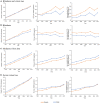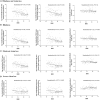Association of sex with the global burden of vision impairment caused by neonatal preterm birth: An analysis from the global burden of disease study 2019
- PMID: 35968463
- PMCID: PMC9363690
- DOI: 10.3389/fpubh.2022.938228
Association of sex with the global burden of vision impairment caused by neonatal preterm birth: An analysis from the global burden of disease study 2019
Abstract
Aims: To investigate the sex-specific global burden of neonatal preterm birth (NPB) vision impairment by year, age, and socioeconomic status using years lived with disability (YLDs).
Methods: The global, regional, and national sex-specific YLD numbers, crude YLD rates, and age-standardized YLD rates of NPB-related moderate and severe vision loss and blindness were obtained from the Global Burden of Disease Study 2019. The Wilcoxon test and linear regression were used to investigate the relationship between sex difference in age-standardized YLD rates and the Human Development Index (HDI).
Results: Between 1990 and 2019, the gender disparity in age-standardized YLD rates for NPB-related vision impairment remained stable, increasing from 10.2 [95% uncertainty interval (UI) 6.7-14.6] to 10.4 (95% UI 6.9-15.0) for men and 10.3 (95% UI 6.8-14.7) to 10.7 (95% UI 7.2-15.1) for women, with women consistently having higher age-standardized YLD rates. Between the ages of 25 and 75, women had higher YLD rates than males, with the biggest disparity in the 60-64 age group. In 2019, sex difference in age-standardized YLD rates across 195 nations was statistically significant. Women had higher age-standardized YLD rates than men in both low (Z = -3.53, p < 0.001) and very high HDI countries (Z = -4.75, p < 0.001). Additionally, age-standardized YLD rates were found to be adversely associated with HDI (male: Standardized β = -0.435, female: Standardized β = -0.440; p < 0.001).
Conclusion: Despite advancements in worldwide NPB health care, sexual differences in NPB-related vision impairment burden showed little change. Female had higher burden than male, particularly in low and very high socioeconomic status countries.
Keywords: Global Burden of Disease; Human Development Index (HDI); neonatal preterm birth (NPB); sex difference; years lived with disability (YLDs).
Copyright © 2022 Ye, Wang, Zhong, Qiu, Yang, He, Lou and Shen.
Conflict of interest statement
The authors declare that the research was conducted in the absence of any commercial or financial relationships that could be construed as a potential conflict of interest.
Figures





Similar articles
-
Socio-economic disparity in visual impairment from cataract.Int J Ophthalmol. 2021 Sep 18;14(9):1310-1314. doi: 10.18240/ijo.2021.09.03. eCollection 2021. Int J Ophthalmol. 2021. PMID: 34540604 Free PMC article.
-
Global burden and gender disparity of vision loss associated with diabetes retinopathy.Acta Ophthalmol. 2021 Jun;99(4):431-440. doi: 10.1111/aos.14644. Epub 2020 Oct 29. Acta Ophthalmol. 2021. PMID: 33124190
-
Secular Trends in Musculoskeletal Rehabilitation Needs in 191 Countries and Territories From 1990 to 2019.JAMA Netw Open. 2022 Jan 4;5(1):e2144198. doi: 10.1001/jamanetworkopen.2021.44198. JAMA Netw Open. 2022. PMID: 35044468 Free PMC article.
-
Global, regional, and national burden of 12 mental disorders in 204 countries and territories, 1990-2019: a systematic analysis for the Global Burden of Disease Study 2019.Lancet Psychiatry. 2022 Feb;9(2):137-150. doi: 10.1016/S2215-0366(21)00395-3. Epub 2022 Jan 10. Lancet Psychiatry. 2022. PMID: 35026139 Free PMC article.
-
Global and regional burden of death and disability from peripheral artery disease: 21 world regions, 1990 to 2010.Glob Heart. 2014 Mar;9(1):145-158.e21. doi: 10.1016/j.gheart.2013.12.008. Glob Heart. 2014. PMID: 25432124 Review.
References
-
- Global Burden of Diseases 2019 Study. (2019). Available online at: https://vizhub.healthdata.org/gbd-results/ (accessed July 1, 2022).
MeSH terms
LinkOut - more resources
Full Text Sources
Medical

